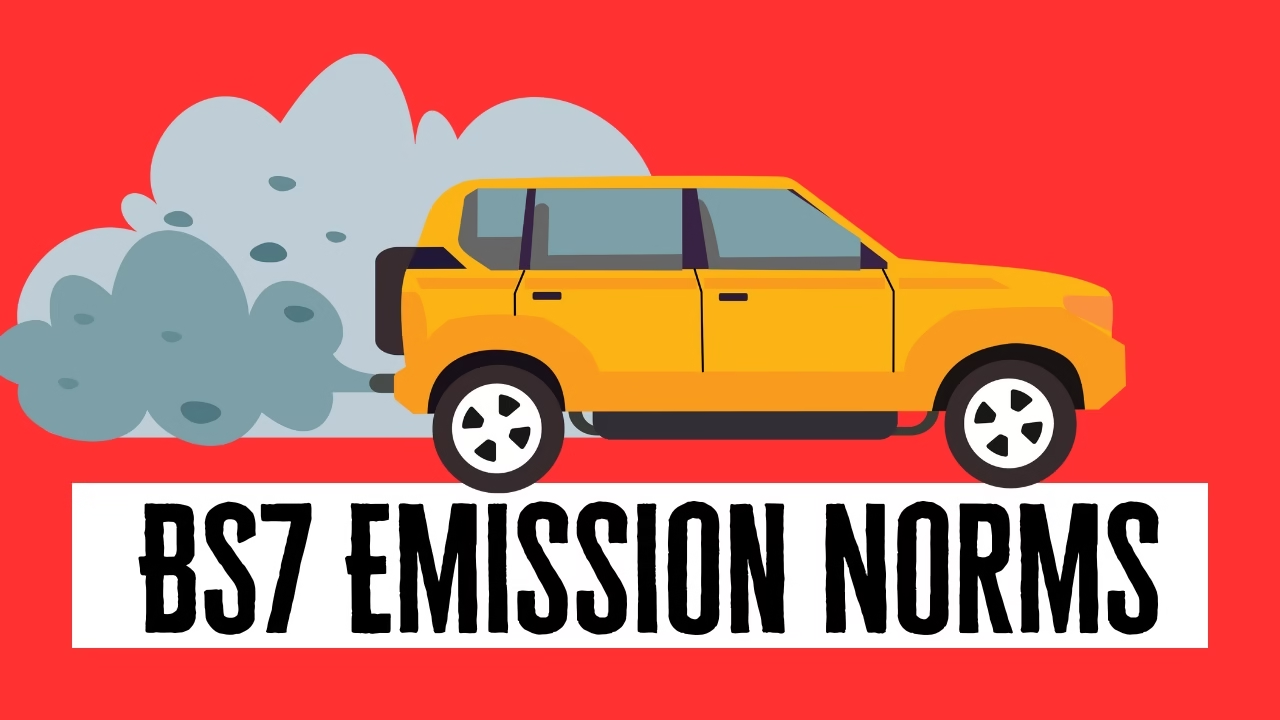India is on the road to stricter vehicle emission rules enforcement, and the next big stop is BS7 Emission Norms. If you’ve been hearing about Bharat Stage 7 norms but aren’t sure what they mean or how they’ll impact your car-buying plans, you’re in the right place.
Contents
- What Are BS7 Emission Norms in India?
- BS7 vs BS6: What’s the Difference?
- What is OBM System in Cars India?
- BS7 Rules for EVs: Not Just for Petrol & Diesel
- Real-World Emission Testing
- Brake & Tyre Pollution? Yes, That Too
- BS7 Effect on Car Prices in India
- Why BS7 Matters for India
- Challenges Ahead for Car Makers
- Will My Current BS6 Car Be Banned?
- FAQs: Bharat Stage 7 Norms
What Are BS7 Emission Norms in India?
BS7, short for Bharat Stage 7, is India’s upcoming vehicle emission regulation. It follows BS6 norms, which came into effect in 2020, and brings India closer to Europe’s Euro 7 standards set to roll out in 2025.
The goal of BS7 Emission Norms is to make air Clean, More smarter vehicles, and stricter control over what your car emits both from the exhaust and even From the tyres and brakes.
BS7 vs BS6: What’s the Difference?
| Feature | BS6 Norms | BS7 Norms |
|---|---|---|
| Based on | Euro 6 | Euro 7 |
| Fuel Type Rules | Different limits for petrol & diesel | Same limits for all |
| Testing | Controlled lab tests | Real-world driving tests |
| Non-tailpipe Emissions | Not covered | Brake dust & tyre wear included |
| Monitoring System | OBD (On-Board Diagnostics) | OBM (On-Board Monitoring) |
| EV Battery Rules | None | Durability tracking added |
| Tamper Protection | Basic | Advanced digital safeguards |
What is OBM System in Cars India?
One of the biggest changes in BS7 is the OBM system—short for On-Board Monitoring.
Think of OBM as a smart emission guard inside your car. It continuously tracks emissions in real time, unlike the current OBD system, which only detects faults after they happen.
OBM will monitor:
- Nitrogen Oxides (NOx)
- Ammonia
- Particulate Matter (PM)
- Engine performance
- Exhaust gas condition
This means cleaner vehicles and fewer chances of pollution cheats.
BS7 Rules for EVs: Not Just for Petrol & Diesel
Even Electric Vehicles (EVs) are part of the BS7 rulebook. While EVs don’t have tailpipe emissions, BS7 focuses on other areas too:
New EV Rules Under BS7:
- Battery durability index: Tracks how long batteries last and perform.
- Non-tailpipe emissions: Covers microplastics from tyres and dust from brakes.
- Tamper protection: Stops people from disabling emission tracking systems.
This will push EV makers to improve quality and battery life great news for buyers.
Real-World Emission Testing
Another major update: BS7 will test cars in real-world conditions, not just in labs.
Your car will now be tested in:
- City traffic
- Open highways
- Hot summers and cold winters
Why? Because lab results often miss what happens on real roads. BS7 solves that.
Brake & Tyre Pollution? Yes, That Too
This is the first time in India that non-tailpipe pollution will be regulated.
Modern cars release:
- Brake dust (tiny particles from stopping)
- Tyre wear (microplastics that mix into the air)
These pollutants can harm lungs and are now under the scanner thanks to BS7.
BS7 Effect on Car Prices in India
To meet BS7, carmakers must upgrade engines, add OBM systems, improve battery tech, and make cars smarter. All this costs money.
Expected Outcomes:
- New car prices may rise by ₹50,000 to ₹1.5 lakh, depending on the segment.
- Small cars may get expensive, but more efficient.
- Older models that can’t meet BS7 will be discontinued.
If you’re planning to buy a car soon, BS7 may affect your budget.
Why BS7 Matters for India
India is now the third-largest car market in the world. But our cities still rank high in air pollution. BS7 isn’t just about regulations it’s about health, climate, and global auto leadership.
By aligning with Europe’s Euro 7, India aims to:
- Boost exports
- Attract global investments
- Lead in clean mobility
Challenges Ahead for Car Makers
there Is A Big challenge For Car makers To Follow BS7 Emission Norms the Have Face The Following:
- Huge investment in R&D and testing
- Supply chain pressure
- Tight timelines to upgrade all models
- Higher production costs
- Possible delays in launching new models
Still, many top brands like Tata, Maruti, Hyundai, and Mahindra are already testing BS7-ready engines.
Will My Current BS6 Car Be Banned?
No. BS6 vehicles will remain legal even after BS7 is introduced. But over time, older cars may face:
- Higher road taxes
- Entry restrictions in polluted cities
- Lower resale value
So, if you’re driving a BS6 car, you’re good for now—but the future is BS7.
FAQs: Bharat Stage 7 Norms
What is BS7 in simple terms?
BS7 is the next step in India’s vehicle emission rules. It brings stricter limits on pollution and adds new rules for EVs, tyres, brakes, and battery life.
When will BS7 be implemented in India?
A final date hasn’t been confirmed yet, but it is expected around mid-to-late 2025, close to the Euro 7 launch in Europe.
Will BS7 affect bike emissions too?
Yes. Two-wheelers will also have to follow new norms under BS7, though with category-specific rules.
Should I buy a car now or wait for BS7?
If you’re budget-focused, buying now makes sense. BS7 cars will be cleaner but more expensive.
Also Read-
First Car Buying Tips in India: Budget, Fuel Type, Safety & More
Underage Driving Laws in India: Penalties, Jail Time & License Ban Explained
RC, PUC, PAN & More: Documents Required to Sell a Used Car in India
RC Transfer After Selling Your Car? Here’s What Supreme Court Says and What You Must Do

